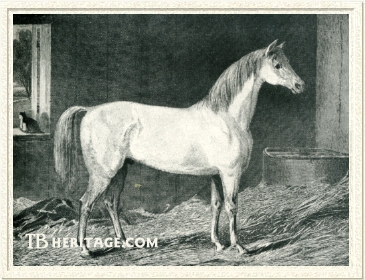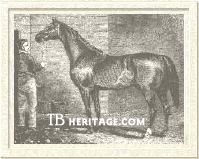|
|
Messenger

|
|
 |
|
|
*Messenger is one of the most important early Thoroughbred stallions brought to North America in the late 1700s. In a sense, he may be considered the most important horse of all, since he stands as a foundation sire to several breeds developed in America including the Standardbred, American Saddlebred, and Tennessee Walking Horse breed. Ironically, *Messenger's influence on the running horse in America was not as significant in the long term.
Bred in England by Lord Grosvenor (Richard Grosvenor, 1731-1802), *Messenger was probably foaled at Oxcroft Stud, at Balsham, Cambridgeshire, where Grosvenor's stallions stood, including *Messenger's sire Mambrino. Grosvenor's horses were later headquartered at the famed stud at Eaton Hall, Cheshire, but at this stage in his racing operation, Oxcroft was the main location, being closer to the racing center of Newmarket, and his training yard at Hare Park. Some sources state *Messenger was bred by John Pratt of Askrigg Stud, North Yorkshire, but there's no proof of this, while Grosvenor is known to have owned both his sire and dam.
Mambrino (1768 by Engineer ‚ mare by Cade) had been bred by John Atkinson of Scholes, Yorkshire. A big, stout horse like his sire and grandsire Sampson, Mambrino had the look of a carriage horse rather than a racehorse. The memorable portrait painted by George Stubbs makes him an imposing animal. It's interesting that this sireline has strong connections with another breed, in that Sampson was sired by Blaze, and Blaze sired a half-bred horse referred to as Old Shales (more likely Old Scholes, for the location), out of a mare by his son Sampson. Old Shales is credited as the founder of the Hackney breed. Blaze was sired by Flying Childers, who, although his descendancy died out among Thoroughbreds early on, is represented by a very viable and prolific modern sireline in Hackneys, Standardbreds, Tennessee Walkers, and American Saddlebreds.
Mambrino was a classy runner and raced for Lord Grosvenor, winning the King's Plate and Jockey Club Plate at Newmarket when seven years old, counting among his beaten rivals the likes of Trentham, Florizel, Comus and Conductor. He was also noted as a fine trotter at speed in harness. Mambrino retired to stud at Oxcroft and there sired a few useful runners and broodmares, as well as becoming known as a sire of road horses, coach horses, and hunters. A son, Grantham, ran second in the Derby of 1785. A daughter, *Mambrina, came to the U.S. and produced the important trio of Gallatin, Eliza and Fairy, all by *Bedford. Daughter Marcella produced Totteridge, Fop, and Enchantress. An unnamed daughter was the third dam of *Maria Black, dam herself of the important American broodmare Bay Leaf (1853). His daughter Primrose was the fourth dam of *Sarpedon (dam's sire of Lexington). But his son *Messenger was the most important by far.
*Messenger's dam was an unnamed daughter of Turf, a son of Matchem, and her dam, "sister to Figurante" was by Regulus, so she was inbred 4x3 to the Godolphin Arabian (grandsire of Matchem and sire of Regulus), with two other crosses 4x3 to Old Starling, who was the dam's sire of both Turf and the sister to Figurante. In 1780, she produced a grey colt by Mambrino who grew into a stoutly-made racehorse of almost sixteen hands, with some racing talent, although not devastating. Running for Thomas Bullock, he won eight of fourteen races from three to five, mostly at Newmarket, mostly over the shorter distance of two and a half miles rather than the four mile standard.
His story becomes a little foggy here, for when we next meet *Messenger, it is when he was imported in May of 1788 by Sir Thomas Benger, of Mount Benger, outside of Philadelphia, Pennsylvania. He arrived at the port of Philadelphia and was said to have charged down the gangplank in a thoroughly unpleasant mood, stirred up from being on board ship for so long and in unfamiliar surroundings. But the temperament didn't improve, although his value as a breeding horse made it worth tolerating.
The grey horse stood that season at the Black Horse Tavern on Market Street in Philadelphia for a fee of fifteen dollars. He was moved on several occasions, and stood variously at Phiip Platt's near Flushing, on Long Island, Noah Hunt's stable in New Jersey, Thomas Clayton's stable back in Pennsylvania, and in 1793, was sold to Henry Astor of New York. In 1796, he was purchased by Cornelius W. Van Ranst, who stood him at his farm in Pine Plains, Dutchess County, New York. A few years later, he was on the move again, standing in New Jersey in several different locations, and finally returning to New York. In 1801, he was advertised at Anthony Dobbin's Inn, Goshen, New York, a location that presaged Goshen as the original home of the American harness horse. *Messenger later alternated standing at Bishop Underhill's stables, Westchester County, and the stables of Townsend Cock, at Locust Valley, Long Island.
It was at this last location that Messenger, age 28, colicked and died on January 28, 1808. He was buried at the farm and by this time, his fame as a stallion required that he be honored as a fallen hero with a military salute of guns. In the early part of the Twentieth Century, a bronze plaque honoring his memory was placed on a boulder near the location of his grave at the entrance to the farm, now known as "Messenger Hill Farm."
As a sire of runners, *Messenger was a good one, but not the equal of his contemporaries -- *Medley (imported 1784), *Shark (imported in 1786), or *Diomed (imported in 1798).
|

American Eclipse as a young stallion
| |
His most important offspring was undoubtedly the filly MILLER'S DAMSEL (1802 out of an imported mare by Pot-8-o's), described by John Hervey as the "Queen of the Northern Turf." A great racemare, she was nearly unbeatable, winning races in her home state of New York, as well as New Jersey, Washington D.C., and Pennsylvania. Miller's Damsel went on to produce an even better one when bred to Duroc, foaling the great champion and leading sire American Eclipse in 1814.
|
Miller's Damsel was a full sister to another good runner by *Messenger in BRIGHT PHOEBUS, perhaps known best anecdotally when he defeated the mighty Sir Archy while the latter was recovering from distemper. A full sister to Miller's Damsel produced the good runner Cock of the Rock (by Duroc), who was later sent to Canada where he became a notable sire.
One of the better runners by *Messenger, TIPPOO SAIB (1795 out of an imported mare by Northumberland) also left an influence as a breeding horse through three good foals, Financier, Mary Grey, and an unnamed daughter who founded the American Family A27.
Mary Grey was also a landmark individual, dam as she was of the important runners and sires Wilke's Wonder (1800 by *Diomed) and Pacolet (1806 by *Citizen). Financier, who was himself out of a daughter of *Messenger, so inbred 2x2 to the great stallion, sired the mare Young Empress, whose granddam was yet another daughter of *Messenger. Young Empress' daughter, Ariel (1822) was one of the greatest runners of the period, and being a daughter of American Eclipse, Ariel was inbred 3x4x4x4 to *Messenger.
Another "celebrated running horse" by *Messenger, HONEST JOHN (out of Slamerkin by *Wildair) was mated with a *Messenger daughter, ZELIPPA (out of Dido by Bay Richmond), to produce the filly Aurora (2x2 to *Messenger). Aurora became the fourth dam of the important broodmare Sally Morgan (1839). Zelippa also produced the filly Honesty (by *Expedition), dam of the runner Monmouth Eclipse (by American Eclipse), and the mare Ethelinda (by Marshall Bertrand). Van Ranst's POTOMAC (out of a mare by Figure) was another good racer by *Messenger.
*Messenger had at least three other running-bred sons who were not as distinguished, but played a significant role in history nonetheless. MAMBRINO (1806 out of a mare by *Sour-Crout) sired the colt Abdallah (1823 out of Amazzonia by Dove), who in his turn, sired the vastly important sire Hambletonian 10 (1849), from which all Standardbreds descend.
SARATOGA (out of a mare by *Expedition, granddam by *Messenger) sired the stallion Dove (also out of a mare by *Expedition, granddam by *Messenger), whose daughter Amazzonia (out of FAGDOWN, by *Messenger) is already noted as the dam of Abdallah.
The third key son of the great grey stallion was HAMBLETONIAN (1804 out of Pheasant by *Shark), who, when bred to *Messenger's daughter SILVERTAIL (1802 out of Black Jin), sired the dam of the Charles Kent Mare (by Bellfounder), dam herself of the famed Hambletonian 10. The ultimate importance of *Messenger as a foundation sire funneled down to this plain-headed trotting machine who had with no fewer than six crosses of the great progenitor to carry the trotting blood forward with remarkable prepotency
--Anne Peters
|
|
|
|

